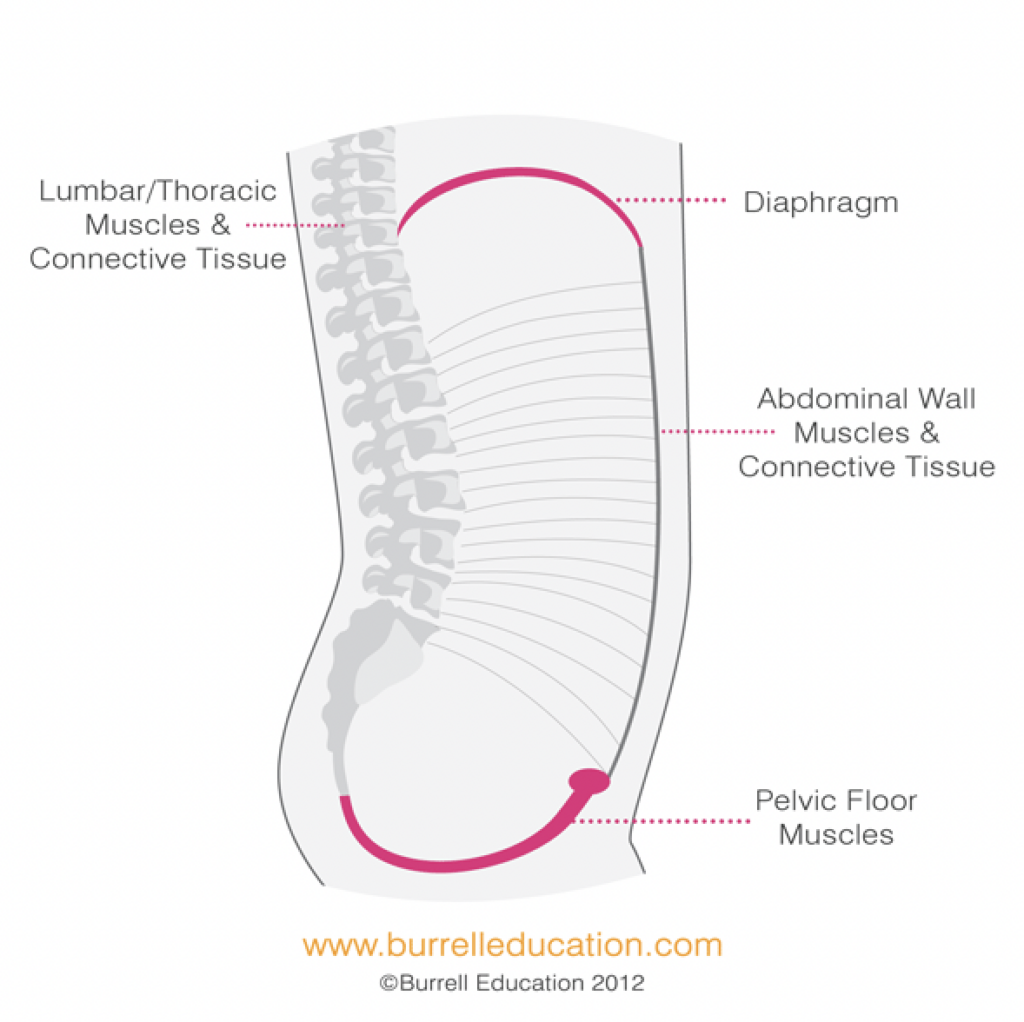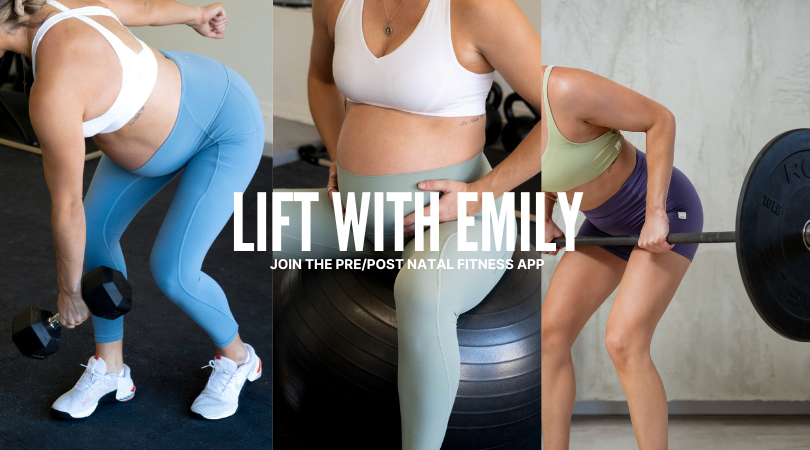There is so much confusion around HOW you should be breathing during your workouts throughout both pregnancy and postpartum. Common questions I hear are; “when should I be inhaling/exhaling?“, “if/when should I be intentionally engaging my pelvic floor“, “what is the best breathing approach to manage XYZ symptoms“. The answer: it depends. There is no ‘right’ breathing approach. Instead, my goal as a coach is to encourage a breathing strategy that works for you with the intention of managing and preserving core and pelvic health symptoms, adjusting to the postural adaptations of pregnancy and considering the demand of that particular exercise.
Learning to breathe correctly is one of the most important things you can do for your core and pelvic health during pregnancy and into postpartum. It’s a powerful tool to stabilize and support your body during movement, manage intra-abdominal pressure and keep your body strong. However, during this season, it can take a little more intention to keep breathing in a manner that supports these key functions.
Diaphragmatic Breathing
The most talked about breathing approach during pregnancy is Diaphragmatic breathing (360 breathing). This is breathing with the entire core stabilization system: your diaphragm (the roof of your abdominal cavity), your transverse abdominals (your corset abs), your multifidus (your back stabilizers) and the pelvic floor (the floor of the abdominal cavity). For an optimal breathing pattern, everything needs to work together in a synchronized and coordinated way.
Diaphragmatic breathing is slow, but it is not forceful. In order to make this breathing pattern happen all day long, you need to train your body how to do it. During pregnancy, as posture/organs shift, the coordination between these muscles are jumbled. When the coordination between inner core muscles is lost, we can begin to see a host of symptoms; low back pain, large abdominal separation, leaking etc.

If you’re struggling to get a full, 360 expansion with your breath, try focusing on:
- Adding a resistance band around your rib cage as feedback. Pull for some resistance, just enough that you should feel a gentle and gradual build of pressure evenly against the band as you inhale into your rib cage;
- Breathing into the back of your body with target back expansion drills;
- Adding in some upper back and rib cage mobility to your routine. If your upper back lacks mobility, your rib cage will struggle to create more space for the lungs to expand on your inhale.
WHO SHOULD USE THIS BREATH: This is a teaching, foundational breath, used to establish connection between the core, pelvic floor and diaphragm. This is an especially good option for anyone who lives in a shallow breathing pattern (breathing into their shoulders/neck) but is something all women should continue to practice and implement throughout their pregnancy.
WHEN TO USE THIS BREATH: A great approach for reconnecting early postpartum; or anyone who needs to learn to connect their breathing to gentle movement; as a warm up/cooldown tool. You would not use this approach during a heavy lift.
DO YOU NEED TO ACTIVELY ENGAGE YOUR PELVIC FLOOR: It depends, if early postpartum and working on the mind-muscle connection or experiencing symptoms, you may need to more intentional with your lift and squeeze.
But HOW should we be breathing throughout heavier, more dynamic lifts?
Let’s break it down…
Foundational Breathing
This is an exhale through the full range of motion that encourages more support and tension to the midline and pelvic floor through the movement.
HOW TO: Inhale, exhale, moving through exhale. You do not need to actively lift/squeeze your pelvic floor as it should be reflexively contracting with your exhale.
A good option for mamas in the third trimester, early postpartum, or for those who experience pelvic floor symptoms. It is also a great strategy for beginners as you do not have it requires less intentional thinking about when you should be breathing.
Dynamic Breathing
This approach focuses on timing the breath with movement. The key is to exhale on the exertion, the hardest part of the movement. For example, inhale as you lower into a squat, exhale as you stand. You do not need to actively lift/squeeze your pelvic floor as it will be reflexively contracting on the exhale.
This is a very practical breath, and can be easily implemented into your training for both management of symptoms and core engagement throughout pregnancy and postpartum.
Valsalva
A controversial breathing approach during pregnancy and early postpartum. This is a breath hold that utilizes an increase in intra-abdominal pressure to create more stability and support in the core system. It’s a “forceful exhale” a breath hold and bracing mechanism.
This is typically a more advanced breathing approach – even outside of pregnancy and postpartum – so when considering implementing it into your training, you want to either be showing signs of readiness (i.e no symptoms) or be well versed in this technique. Valsalva should also be adjusted for anatomical needs and symptom thresholds. I would advise to avoid valsava during loaded movement throughout the later stages of pregnancy, but again, this may be totally fine for your more advanced athlete. Research has shown that using a valsalva movement does not harm the pelvic floor, but bearing down and straining does. Valsalva and straining are too very different pelvic floor activation patterns and for many, it’s more so your technique rather than the breath hold itself. That being said, if you are someone that has not mastered this technique, it will likely not suit you during this time.
The valsalva is usually is applied to heavy loads, typically over 80% of 1 rep max which you will not be doing during pregnancy or in those early months postpartum. You will likely not be ready to reintroduce until you have practiced under lighter loads. This will allow you to get a sense of how your body responds to the breath and brace.
Downtraining
A breathing technique to consciously relax and lengthen your pelvic floor. This is a good option for anyone who carries a lot of tension in their pelvic floor, is experience pain/any pelvic floor symptoms, constipation or are preparing for birth. I encourage ALL my pregnant and postpartum clients to include this technique into their routine daily, whether thats prior or post workout, or stand alone throughout the day.
HOW TO: Breathe into your lower abdomen and glutes so you can feel them “let go”. Your belly should feel relaxed. It may take a few breaths to start feeling yourself let go and relax as we often carry a lot of tension in our pelvic floor.
Practice in a variety of different positions. Use in supine position, legs elevated, all fours, on a birth ball, including at the end of a training session. This approach is also great for preparing for birth and should be a huge focus in your training from 35+ weeks.
All of these – and more – are broken down in my Strong in Pregnancy and Return to Strength training programs.

I’m deeply passionate about helping women feel strong, informed, and confident through every stage of motherhood. You deserve more than just a list of do’s and don’ts or generic modifications. With years of hands-on coaching across all kinds of athletes and clients, I blend real-world experience with specialized pre and postnatal knowledge to create strength programs that go far beyond basic adjustments. This is high-level, accessible training - built for your body, your season, and your goals
EXPLORE MORE POSTS